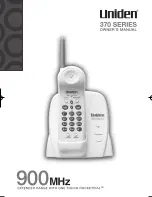
Appendix B: Integrating Cisco Unified Communications Manager and Cisco Unified SRST to Use Cisco Unified SRST
How to Use Cisco Unified SRST Gateways as a Multicast MOH Resource
307
Cisco Unified SCCP and SIP SRST System Administrator Guide
OL-13143-04
connection on an E&M port does not require loop current.) The
signal immediate
and
auto-cut-through
commands disable E&M signaling on this voice port. A G.711 audio packet stream is generated by a
digital signal processor (DSP) on the E&M port.
In Cisco IOS Release 12.4(15)T and later releases, you can directly connect a live-feed source to an FXO
port if the
signal loop-start live-feed
command is configured on the voice port; otherwise, the port must
connect through an external third-party adapter to provide a battery feed. An external adapter must
supply normal telephone company (telco) battery voltage with the correct polarity to the tip and ring
leads of the FXO port and it must provide transformer-based isolation between the external audio source
and the tip and ring leads of the FXO port.
Music from a live feed is continuously fed into the MOH playout buffer instead of being read from a
flash file, so there is typically a 2-second delay. An outbound call to an MOH live-feed source is
attempted (or reattempted) every 30 seconds until the connection is made by the directory number that
was configured for MOH. If the live-feed source is shut down for any reason, the flash memory source
automatically activates.
A live-feed MOH connection is established as an automatically connected voice call that is made by the
Cisco Unified SRST MOH system itself or by an external source directly calling in to the live-feed MOH
port. An MOH call can be from or to the PSTN or can proceed via VoIP with voice activity detection
(VAD) disabled. The call is assumed to be an incoming call unless the
out-call
keyword is used with the
moh-live
command during configuration.
The Cisco Unified SRST router uses the audio stream from the call as the source for the MOH stream,
displacing any audio stream that is available from a flash file. An example of an MOH stream received
over an incoming call is an external H.323-based server device that calls the directory number to deliver
an audio stream to the Cisco Unified SRST router.
Prerequisites
Cisco Unified SRST for multicast MOH, as described in the
“Configuring Cisco Unified SRST for
Multicast MOH from an Audio File” section on page 296
, is not required for the MOH live-feed
configuration. However, MOH live feed is designed to work in conjunction with multicast MOH.
Restrictions
•
An FXO port can be used for a live feed if the port is supplied with an external third-party adapter
to provide a battery feed.
•
An FXS port cannot be used for a live feed.
•
For a live feed from VoIP, VAD must be disabled.
•
MOH is supplied to PSTN and VoIP G.711 calls. Some versions of Cisco Unified SRST provide
MOH to local phones. On Cisco Unified SRST that do not support MOH for local IP phones, callers
hear a repeating tone on hold for reassurance that they are still connected.
•
Conditions may occur within your network that is caused by brief spikes of a higher CPU usage.
Small spikes in CPU usage can temporarily affect the quality of the MOH heard by parties connected
via TDM (FXO / PRI / CAS) interfaces.
Setting Up the Voice Port on the Cisco Unified SRST Gateway
Use the following procedure to activate MOH from a live feed and to set up and connect the physical
voice port.
















































